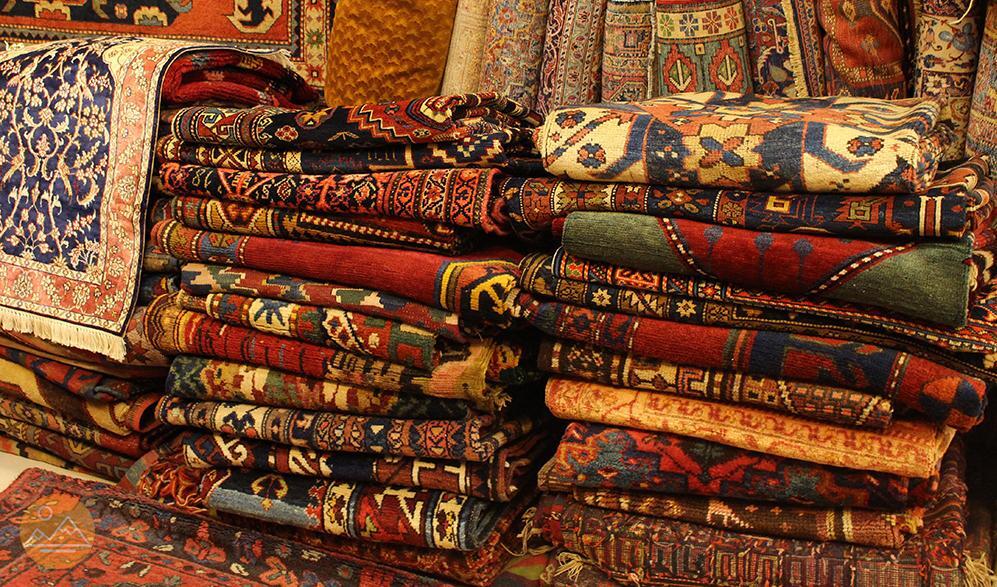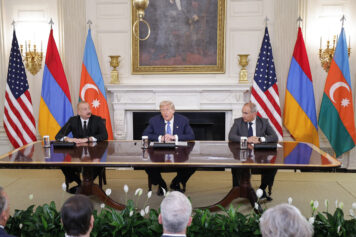Reclaiming Stolen Legacy: Uncovering the Faith-Woven History of Armenian Rug-Making
24.10
2025
In the fall of 2025, Canadian-Armenian Arto Tavukciyan travelled to Armenia in search of missing fragments of his nation’s artistic legacy. A year earlier, as he set out to write a book on the role of Armenians in rug-weaving, he uncovered astounding historical traces that revealed his nation’s deeper connections to the global history of carpet-making.
Born to Armenian parents who left Turkey after the 1955 Istanbul Pogroms, young Arto developed a fascination with rugs – “a rug enthusiast”, as he would later call himself.
“There was always something appealing to me about rugs,” says Arto, a graphic designer in his 60s. “Of course, I knew Armenians were involved in it, but nothing more than that. One thing I did know was that I liked Kazak Caucasian designs very much—their abstract symbolism. I was not that attracted to Persian rugs. They are very fine, very nice, but I like things that make you think, you know.”
Arto recalls that it was only in his fifties that his hobby led him through some studies and eventually to a discovery about his own nation.
“I discovered,” Arto says, “that there is a much bigger story. First, I found out that Armenians actually wove most of those Kazak Caucasian rugs, Karabagh rugs, East Caucasian rugs, and even many Persian and Anatolian rugs.”
He gradually realized that the story of Armenian carpets mirrors the tragic history of his nation, spanning centuries—a story long buried by its foes and now being brought to light by him.
Unearthing Hidden Traces of the Armenian Genocide
In the early 20th century, popular theories of rug-making ignored the Armenian contribution in the region, attributing all carpets to Turks and Persians.
“Before 1915,” Arto says, “you could see many old books attributing rugs to Armenians, but even then, they did not understand the full extent. After the 1915 Genocide, when Armenians were completely eliminated from Anatolia, we were in survival mode and could not even think about preserving our culture.”
The Soviet state discouraged any nationalistic aspirations and research in rug-making, and as a cultural element, Armenian contributions were largely ignored, grouped instead into the generalized category of “Caucasian culture.” In Western countries, where Turkish influence extended, scholars upheld the Turkish narrative, claiming that all rugs made in Anatolia were of Turkish origin.
Another group of scholars, including Arthur Upham Pope, attributed many carpets made by Armenians to Persians.
“In the 1930s, Pope said there was absolutely no proof that Armenians ever wove carpets,” Arto says, “and it became the accepted view. He went to Anatolia, where there were no Armenians living at the time. Armenians had been expelled by then, and the Turkish government had brought Kurds from Iraq to populate the area. Since he saw no Armenians there, he concluded that there was no proof Armenians had ever woven carpets. Many other scholars, such as German scholar Erdmann, also claimed that all carpets were made by Turks. In fact, this resulted in Persian and Turkic appropriation of Armenian weaving.”
In Pursuit of the Truth: “A Broken Nation” That Needs to Bring Pieces Together
Then, in his search for the truth, Arto accidentally came across a book by German art historian Volkmar Gantzhorn, who made a bold claim in his 1992 book The Christian Oriental Carpet.
“Gantzhorn attributed most rugs, or at least their designs, to Armenians,” he says. “According to him, Armenian art had been stolen by conquerors, who then claimed it as their own.”
This prompted Arto to dig even deeper, gradually uncovering the truth for himself: the story of Armenian rug-making is the story of his Nation’s exiles.
“Gantzhorn’s ideas were not widely accepted in the 1990s, as carpet scholarship was completely focused on Islamic and Turkic art. Scholars believed that all these rugs had Turkic designs and that such elements originated in the 11th century, when Turks entered Anatolia. They thought that rug-making in Anatolia began at that time. But this is not true at all.”
Later, Arto came across another publication by English scholar R.F. Sergeant, Islamic Textiles Until the Mongol Age. The British historian cites numerous quotes from Arab historians, who mention Armenian rug production from the 8th to the 13th century. According to these sources, Armenian carpets were among the finest and were woven in and around Armenia.
“Turks or Seljuks are mentioned only once or twice in that book,” Arto says.
Then Arto discovered a book titled Armenian Ornamental Art by Armen Kyurkchyan and Hrair Hawk Khatcherian. It showed in detail the motifs on Armenian churches and manuscripts which were similar to those found on antique carpets.
“I could see that the motifs of those nakhshs – the ornaments were very similar to those on the rugs,” says Arto. “This book was very important to me. It showed some close-ups and variations of some typical Armenian motifs from the 9th and 10th centuries, which I could see on the rugs from the 18th and 19th centuries.”
Tavukciyan then discovered many more historical sources.
“I found that Armenian illustrative manuscripts are a very rich resource for the motifs that we see on carpets today,” he says. “Yet carpet scholarship has largely ignored this. Probably many factors contributed to the attribution of Armenian rugs to Islamic traditions.
“But once I started doing research, everything changed for me,” Arto recalls. “Now I understand that the story of the Armenian rug is the story of Armenian forced displacement. Wherever Armenians were sent, something new emerged in the rugs—new designs. I used to think that the Armenian diaspora formed only in 1915, but as I researched, I realized that it has existed since the 5th or 6th centuries.”
For example, at the beginning of the 6th century, there were the Sassanids and the Byzantines. The Byzantines tried to bring Armenians to their side, to Cappadocia. Thus many Armenians settled in Cappadocia; that is where Cappadocian carpets began. The Sassanids, in their turn, having conquered Egypt, sent Armenians there.
“That is why we have very old fragments known as ‘Fustat’ in museums from the 5th and 6th centuries,” Arto explains. “Some people believe these were Coptic pieces, but Sergeant says, ‘No, Armenians made these! The Armenian people taken by the Sassanids to Egypt made them.’ Then, in the 7th century, Arabs came and took many Armenians to Cairo to build their mosques, because Armenians were skilled builders.”
Between the 10th and 12th centuries, during the period of the Fatimid Empire, Islam-converted Armenian viziers governed Cairo for over 200 years. At that time, there were 100,000 Armenians in the city and 30 churches. Many more Armenians arrived after the Seljuk invasion of Anatolia, drawn to Egypt because it was governed by Armenians. It was during this period, that the Armenian kingdom of Cilicia was established and thrived until the 14th century.
“In Cilicia, they were making very beautiful rugs and textiles,” Arto states. “Then the Mamluks invaded and destroyed Cilicia in 1375, and Armenians from Scevra and Hromkla relocated these artists to Cairo. That’s where a particular type of rug emerged, called the Cairene rug—a very beautiful rug.”
“Then, in the 1400s, Tamerlane conquered Armenia and moved 120,000 people—including 60,000 from the Caucasus, many of whom were Armenian craftsmen—to Samarkand to build his city. Historian Thomas of Metsoph recorded this in his book, and the Spanish ambassador to Timur’s court, De Clavijo, also confirmed it.”
“And those were mainly the artists who produced art for Timur,” Arto explains. “That’s why, when you look at Timurid art, it closely resembles Armenian manuscripts.”
Then, in the 15th century, when the Turks captured Constantinople, they resettled many Armenian artisans—including goldsmiths from Van (now in eastern Turkey)—to Istanbul to create jewelry for the Sultan. In 1514, Sultan Selim captured Tabriz and relocated 3,000 Armenian artisans from there to Istanbul. In 1517, Selim conquered Egypt and brought 500 Armenian artisans from Cairo to Istanbul.
“And something new happened here,” Arto recalls. “A new type of rug emerged then, called the Ottoman medallion rug. That is when it all appeared.”
The last migration of Armenian carpet-makers that Arto mentions occurred in 1604, when Shah Abbas of Iran uprooted 300,000 Armenians from Nakhijevan to resettle in Isfahan. That is when Safavid carpets began to be produced.
“So, every time there was a forced migration, something new would emerge,” Tavukciyan concludes.
Armenians: Catalysts of Culture in the Middle East
“However, I am not saying those rugs were purely Armenian,” Tavukciyan says. “Every time we entered a new environment, we acted as catalysts—we were agents of change. We created something new from that environment. So, as I said, the story of the rugs is the story of Armenian displacement. But there is a second aspect: the story of the rugs is also a story of Armenian survival. We were very useful to our conquerors because we were craftsmen, artists, and artisans—so we have survived. And, of course, all our art, everything we created, was taken as their own by others.”
Arto stresses that this is the central idea of the book he is currently working on. He embarked on this project largely encouraged by his Facebook followers.
“I will show a lot of visual evidence there,” he promises. “Just like the snakes here,” he points to the motifs on the rugs, “I have hundreds of examples of different motifs that have Armenian origin and have been appropriated not only by Turks but also by Persians and incorporated into their arts. But I am going to remind them of these things.”
“When Two Armenians Meet…”
As he recalls, even though carpet scholarship after 1915 had largely erased Armenians from the history of carpets, things began to change in the 1970s, when the Armenian Rug Society was founded in California.
“They were dealers who got together, started organizing exhibitions, and even produced a few books. But scholars still did not take these efforts seriously until the 1990s, when Gantzhorn’s book was published, asserting that everything woven in Turkey was mostly Armenian.”
Paying Tribute to the Great Scholar
Arto says that Gantzhorn was ridiculed by experts in carpet studies in the 1990s, but his book contained important revelations that served as a guiding light for Tavukciyan.
“He has been a great inspiration for me, no doubt. He was the first person who really understood the roots of rug design. But he did not have all the resources I have today. I can see almost every rug in every museum online. Although Gantzhorn did research at the Matenadaran—a large repository of ancient manuscripts in Yerevan—he did not have access to the full digital collection in the 1990s like I do today. That’s my advantage, and I intend to make the most of it.”
Arto thinks that now he can see the bigger picture which will allow him to bring all the pieces together.
“Today I went to the Matenadaran and a very old manuscript that I saw today was from 1057 called Gospel of Melita, Malatia. I noticed some incredible things. I saw a rug in the headpiece of a manuscript that had two facing serpents – օձ (snakes in Armenian) – with an object in between. This motif also appears on so-called Seljuk rugs in the Turkish museum, which are supposed to date from the 13th century, but I believe it belongs to an earlier period, even though they are all attributed to Turks. Everyone assumes that the border is pseudo-Kufic, a form of Arabic writing, but that is not true at all. Now, facing serpents with an object in between—usually a cross—what does that remind you of? Մերին հայկական տեր-հայրերուն գավազանը․ [author’s note: the upper part of the clergymen’s wand is usually depicted in the form of snake heads]. It could have been made both for the church and for homes, meant to protect the interior.”
Social Media: A Tool to Educate People and Fight for Rights
“Now, as I have done a lot of research, I have over 10 thousand followers on Facebook and Instagram. I always post things on FB (and people like it) about certain symbols and tie them to the rugs and show that it is not Islam or Turkic element, it is a part of the Armenian culture.”
“Now, having done a lot of research, I have over 10,000 followers on Facebook and Instagram. I regularly post on Facebook—people seem to like it—about certain motifs, linking them to rugs and showing that they are not Islamic or Turkic elements, but part of Armenian culture.”
When Arto first began writing about Armenian rugs on Facebook, he noticed there wasn’t much interest in carpets among Armenians.
“Yes, they knew Armenians wove rugs, but how far back it goes—they didn’t know, and they didn’t care much about it either. But now, after five years of educating people, I see many are interested, especially young people. When I show a matching Armenian manuscript, all of a sudden, the light appears—I can see that young people are interested in carpets now. And I can even see them buying carpets, too.”
“There are professional rug groups on Facebook, and huge fights break out on social media,” Arto says. “When I first joined professional rug groups, there weren’t any Armenian voices—it was just me arguing against Turks and Azeris. But now, there are lots of people speaking up, lots! I’m very happy about that, and I’d like to take a little credit for it, because people have started to get interested in rugs. It’s really important to get involved in the protection of your identity on social media.”
Moreover, Tavukciyan takes quiet satisfaction in seeing many foreigners have changed their views on the origins of rugs.
“There was a rug collector from Norway, Petter Andreas Haug. He has a huge collection of rugs. When I first told him that a rug [he displayed] did not belong to Azeris but to Armenians, he blocked me for almost two years. He could still somehow see my posts on some sites, though. Eventually, he unblocked me, and we started talking a lot. His entire collection has now changed—he has completely changed; when a certain item is Armenian, he acknowledges it as Armenian.”
Reflecting on Pressing Issues and Their Solutions
Tavukciyan believes there is still much work to be done to help wealthy Armenians understand the importance of acquiring valuable old Armenian rugs that appear at international auctions.
“As we are not strong buyers, the auctions—where Turks and Azeris purchase these historic rugs—naturally cater to them; and the rug scholars do the same, because that’s where the money comes from. If Armenians don’t buy their own art, you see, that’s a big problem.”
Tavukciyan believes there are several fundamental issues that the state must address, as rugs are an important part of Armenia’s cultural heritage. He says the most pressing of these is the establishment of a large museum of rugs.
“We don’t have a large museum like the Azeris do; their collection is mostly made up of Armenian rugs,” he laughs. “I always say the best Armenian museum of rugs is in Baku.”
According to Arto, Armenia’s current rug collection is mainly split between the History Museum and the Folk Museum. Two large rug businesses that contribute greatly to the country’s cultural heritage are Tufenkian and Megerian Carpets.
“Tufenkian has been involved in rug production for a long time. They have produced rugs in Nepal, Tibet, and recently in Armenia. Interestingly, the owner has only seriously started collecting rugs in the last five years,” Tavukciyan says. “He [the owner] now wants to build a great collection of Armenian rugs because, like me, he understands that these rugs are of Armenian origin and that we have to buy them.”
Tavukciyan thinks Armenia needs to buy back what truly belongs to it—“better, older, more historical rugs,” which can be found at Auctions.
“Incredible rugs are still being sold at auctions,” he says, “because collectors eventually die, and their collections end up at auctions. All of this should be organized by the state.”
Arto’s voice turns resolute:
“Why is this so important to realize? Turkey and Azerbaijan want to deny that Armenians wove rugs. Rug weaving was an important factor of the region. If you deny that Armenians wove rugs, it implies that Armenians were not part of that region. This is their whole political strategy. What they claim is that Armenians never wove rugs and only came here in the 19th century—some crazy things! So, rugs are more important than anyone realizes.”
In response to the question of whether he thinks appropriation of art pieces is an element of genocide, Tavukciyan replied:
“Yes, it is secondary evidence. It is genocide. First you annihilate people, then you take over their culture.”





